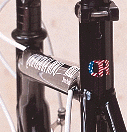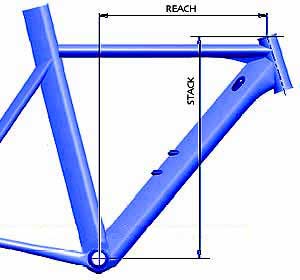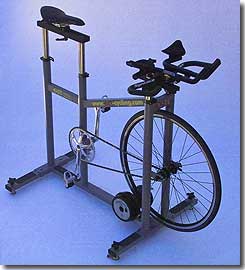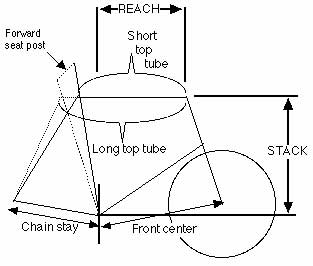Frame sizing problems, Part I: Beware of T-shirt nomenclature

Whatever happened to the bike size? We old timers remember when, if you rode a 56 centimeter bike, another model you were contemplating in that same size would fit about the same way. It also meant that if you held your measuring tape up to the bike's seat tube — lo! — it terminated 56 centimeters above the bottom bracket.
One of the measuring conventions back then was center-to-center, which meant you measured from the center of the bottom bracket to the center of the intersection between the seat and top tubes. The other standard was center-to-top (BB to the top of the seat tube).
If you own a tri bike I charge you with this task: hold a tape up to it and find any two landmarks of note that actually measure the amount corresponding to its named numerical size.
It won't so-measure, and I'm as much to blame as anyone for this. When I was making tri bikes 20 years ago we decided to drop the top tube, and run it horizontal to the ground. We extended the seat tube up to its usual place: for looks; and to provide our customers with a place to which to measure (the black bike in the pic above is an example of a model like that built by QR about a dozen years ago, with an embarrassing number of headset spacers). By-and-by we just said screw it, and cut the seat mast off just above the top tube intersection. How did we then describe the bikes' sizes? We kept the "size" the same, even though we had no tube up there anymore.
"Center-to-air," we'd answer when asked how we measured. We sized our bikes from the bottom bracket to where your top tube would be if you were on a road race bike that fit the same way. Was that disingenuous? Cynical? Demeaning? Heck, I don't know. What I do know is that it caused us few-to-no problems. Can you imagine how much time it would've taken to explain that last year's 57cm QR Kilo fits exactly the same as this year's 52cm Kilo?
Which brings us to now.
The problem of sizing is acute in the world of tri bikes. Any system of sizing would be okay with me, if it was uniform. I'll use T-shirt sizes as an example of how munged-up things are, but I've got to use a precise and repeatable method of actually measuring a bike to demonstrate the current state of affairs.

One such measuring standard is that which I use for our F.I.S.T. Tri Bike Fit system, and that standard is called "stack & reach." Simply put, I'm measuring between the two points on a frame you'll contact: the bottom bracket and the head tube top. "Stack" is the distance between these two points on the Y axis, that is, if you draw horizontal lines between the BB and the head tube's terminal height, the distance between these two lines is "stack." The difference in length between these two points along the X axis is "reach."
Stack & reach tell you everything you need to know about a bike's height and length. This leaves out a lot of very valuable geometric information, but most all that other stuff relates to how the bike will handle.
With this as a backdrop, let us examine some frame sizes.
Let's start with the Scott Plasma, in size M. It's got a stack of 52.7cm, that is, it's got its head tube top exactly that number of centimeters above the bottom bracket in the vertical plane. Is this a reasonable height for a tri bike in size M? Maybe so. But the new Specialized Transition S-Works has a stack of 52.6cm in its size L. These are pretty much identically sized bikes, in terms of height.
Certainly the Plasma must be shorter in length, so as to justify its smaller size designation. Its reach in 40.4cm. The Specialized? Its reach in size L is 40.5cm. If you think the Scott Plasma in M is smaller than the Specialized Transition in L just because one's M and one's L, think again. These are identical bikes, when it comes to their (handlebar) height and (cockpit) length. The only difference in the fit of these two bikes may be in one's ability to position the saddle differently (more forward or rearward, or higher or lower) versus the bottom bracket.
Does this continue throughout the T-shirt size ranges? Yep, it does, to a degree.
The Scott Plasma, size S, has a stack and reach of 51.5cm and 39.2cm, while the Specialized Transition in size M has a stack and reach of 51.6cm and 39.5cm.
Which bike company has it right? Hard to tell. Giant's Trinity Alliance in its size S has a stack of 51.7cm, which is pretty closely in line with the Plasma's size S. But the Giant's reach is 41.0cm, which is even longer than the Scott's Medium and the Transition's size L.
Does this mean the Giant's size S is way too long for a bike of that size? Maybe, but don't tell that to Argon18. Its E-112 and E-114 in size S has a reach about the same (41.1cm) as Giant's S. But that bike's stack is 49.5cm, and that's lower to the ground than Giant's size XS.
Trek's Equinox TTX is a bit shorter in length in its size S, with a reach of 39.0cm. That's the same reach as the Kuota Kueen K in size XS. But Trek's stack for that size S is 52.0cm, and that's the same as Elite's stack in size M, and halfway between the Specialized Transition's M and L.
Scott's Plasma jumps in height by a centimeter in going from XS to S, by a centimeter-and-a-quarter from S to M, then by two centimeters from M to L. it's XL is three-and-a-quarter centimeters taller than its L.
Trek's Equinox TTX jumps just one centimeter in height between its S and M, then by almost 4 centimeters between the M and L.
Meanwhile, the tri bikes by Specialized differ in height by only 2.2cm throughout its entire 4-bike size range of S to XL. Indeed, the S Works XL is the same height as the Scott Plasma in M, and it's only 7 millimeters taller than Trek's size S.
Jamis new Xenith, in size M, is same length as Kuota's K Factor in size L, which places it between Blue's ML and its L, and halfway between Argon18's Mercury in M and its E-114 in M. But in height it's lower than the K Factor's S, and it's lower than Trek's S too.
Imagine if, upon going shopping at the mall, S meant a neck of 15 inches and a sleeve of 32 inches, but in another brand the neck was 13 inches and the sleeve was 35 inches. You might wonder why these companies don't use numeric designations, so that they can add some accuracy to their size designations. Surely a 56cm Cervelo must be akin in size to a 56cm QR or Felt or Kestrel. Think again. That's coming in Part II.




Start the discussion at slowtwitch.northend.network